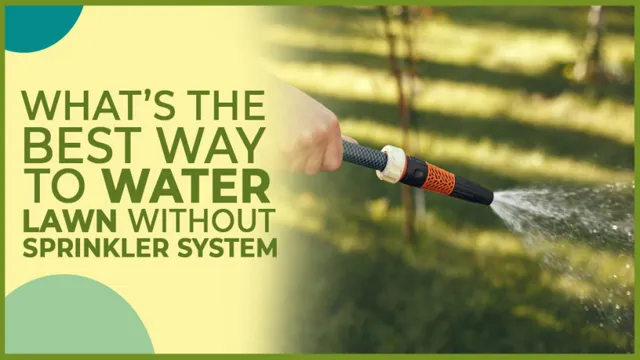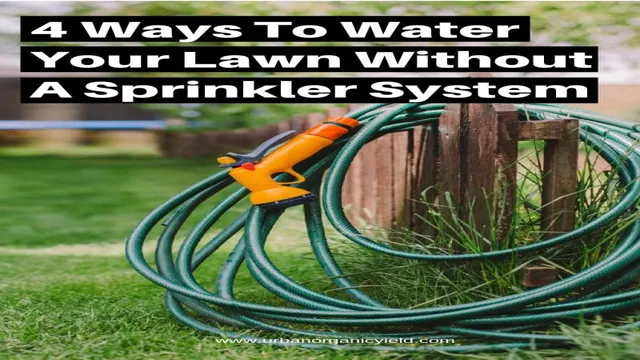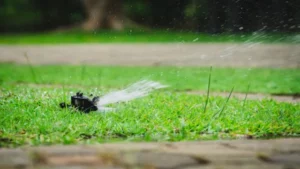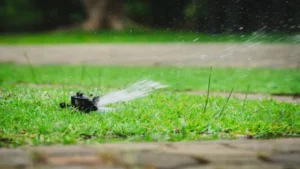A beautiful lawn is a pride for any homeowner, but keeping it well-watered can be a challenge, especially if you don’t have a sprinkler system installed. Whether you are looking for cost-effective ways to water your lawn, or simply want to reduce your water footprint, there are plenty of options available. From DIY solutions to smart watering systems, this blog post has got you covered with plenty of tips and tricks to keep your lawn healthy and well-maintained without a sprinkler system.
So, get ready to ditch the sprinkler, and let’s explore some ways to make your lawn greener and lush!
Assess Your Lawn’s Needs
If you don’t have a sprinkler system, don’t worry, you can still keep your lawn looking healthy with a little effort. The first step is to assess your lawn’s needs. Determine the type of grass you have as different varieties have different watering requirements.
Also, consider the climate in your area and the season. In general, lawns need about an inch of water per week, but during hot, dry weather, they may require more. You can use a hose and a sprinkler attachment or a watering can to water your lawn.
Water early in the morning or late in the evening when the sun isn’t as strong to prevent the water from evaporating too quickly. Remember to water deeply but infrequently to encourage strong root growth. By understanding your lawn’s specific needs, you can keep it lush and green without a sprinkler system.
Determine the Type of Grass You Have
Before making any decisions about caring for your lawn, it’s important to assess its needs. This includes determining the type of grass you have and the specific requirements of that variety. Each grass type has different characteristics, such as growth rates and water needs, which can impact how often you need to mow, fertilize, and water your lawn.
Understanding the type of grass you’re dealing with can help you make informed decisions about how best to care for it. Some common grass types include Bermuda grass, which is known for its drought tolerance, and Kentucky bluegrass, which is well-suited to cooler climates. By taking the time to assess your lawn’s needs, you can ensure that your grass looks its best and stays healthy all season long.

Check the Soil Type and Its Moisture Level
When it comes to caring for your lawn, assessing its needs is crucial for ensuring optimal growth and health. One important aspect to consider is the soil type and moisture level. Different types of soil require different care methods, such as amending the soil with compost or fertilizers.
Additionally, a lawn’s moisture level can greatly impact its health. Overwatering can lead to mold and disease, while underwatering can cause the grass to dry out and die. By regularly checking the soil type and moisture level of your lawn, you can tailor your care routine to meet its specific needs and promote healthy growth.
Don’t neglect this important step in lawn care and watch your lawn flourish!
Use a Hose and Sprinkler Attachment
If you don’t have a sprinkler system, don’t worry, you can still achieve a green lawn by using a hose and sprinkler attachment. Firstly, ensure that your hose is long enough to reach all areas of your lawn. Then, attach a sprinkler head to the end of your hose, making sure it is the right type of sprinkler for the job.
For example, oscillating sprinklers are great for large lawns, while stationary sprinklers work well for smaller areas. Make sure to position the sprinkler head in the center of your lawn, and adjust it to spray evenly across the entire area. Move it every 30 minutes so that all areas get equal amounts of water.
Remember to water your lawn in the early morning or late evening to avoid evaporation, and avoid over-watering as it can cause damage to your lawn. With these simple steps, you can ensure your lawn stays green and healthy, without the need for a sprinkler system.
Select the Right Type of Sprinkler Attachment
Using a hose and sprinkler attachment can take your gardening game to the next level. However, selecting the right type of sprinkler attachment is crucial to get the best results. The two most common types are oscillating and pulsating sprinklers.
Oscillating sprinklers are perfect for watering rectangular or square-shaped gardens and come with adjustable nozzles to control the water pattern and intensity. Pulsating sprinklers, on the other hand, are ideal for circular gardens and emit water in a circular pattern. The type of sprinkler you choose will largely depend on your garden’s shape and size, as well as your watering preferences.
When using a hose and sprinkler attachment, it’s important to find the sweet spot between watering too much and too little, as well as being mindful of water conservation. With the right attachment and technique, you can enjoy a lush, healthy garden all season long. So, it’s time to start digging in the dirt and watch your garden flourish!
Water Your Lawn Slowly and Deeply
Watering your lawn is a crucial part of lawn maintenance, and doing it properly can have a big impact on the health and appearance of your grass. One important tip for watering your lawn is to do it slowly and deeply. This means using a hose and sprinkler attachment to water your lawn for an extended period of time, rather than just quickly spraying it down.
When you water your lawn deeply, you encourage the roots to grow deeper, which improves the overall health of the grass and makes it more resistant to drought and other weather conditions. So, next time you water your lawn, try using a hose and sprinkler attachment, and let the water soak in for at least 30 minutes. Your lawn will thank you for it!
Water Your Lawn Early in the Morning
If you want a lush, green lawn, you need to give it the right amount of water. But when is the best time to water it? The answer is early in the morning. Using a hose and sprinkler attachment will help you achieve this.
Here’s why: when you water your lawn early in the morning, the grass has time to absorb the water before the heat of the day evaporates it. This means your lawn will stay hydrated throughout the day, leading to healthier roots and more vibrant foliage. Plus, watering before sunrise can help to prevent fungal growth, which is more likely to occur when the grass stays damp overnight.
Using a hose and sprinkler attachment allows for precise water distribution, so you can ensure every inch of your lawn is getting the hydration it needs. So next time you’re out tending to your yard, try watering it early in the morning with a hose and sprinkler attachment for the best results.
Create a DIY Irrigation System
If you’re looking for ways to water your lawn without installing a sprinkler system, DIY irrigation may be an excellent choice. Creating your irrigation setup can seem daunting, but with the right materials and some effort, it’s easy to accomplish. Your irrigation system can be as simple or complex as you like, depending on the size of your lawn and plants’ water needs.
A drip irrigation system is an efficient and cost-effective option for most households. It uses a network of tubes, valves, and emitters that slowly release water into the soil. This method ensures the plants receive the required water amount at an adequate pace, making it less wasteful and more effective.
You can tailor the flow rate and frequency of water, depending on your plants’ needs, ensuring the best result. With some research and effort, creating a DIY irrigation system is an alternative way to maintain a healthy lawn and garden without the cost of a sprinkler system.
Use a Soaker Hose to Water Your Lawn
If you’re a homeowner who wants to keep their lawn looking pristine, you know how important watering is. But it can be time-consuming to hand-water every section of your lawn with a hose, especially during the hottest months of the year. That’s where a DIY irrigation system can come in handy.
One option is to use a soaker hose, which is designed to slowly release water along its entire length, effectively watering your lawn and conserving water at the same time. All you need to do is connect the soaker hose to a water source, lay it across your lawn, and turn on the water. As the water seeps out of the hose, your lawn will receive a slow and steady stream of hydration, reducing the amount of water that evaporates into the air.
To maximize the benefits of your soaker hose, it’s important to position it correctly and adjust the water pressure to ensure proper saturation. Using a soaker hose is an affordable and effective way to keep your lawn green and healthy all season long.
Make Your Own Drip Irrigation System
If you’re looking to create a DIY irrigation system, a drip irrigation system could be just what you need! Using this system, you’ll be able to easily water your plants while minimizing water waste and ensuring that each plant receives the perfect amount of water. The process for creating a drip irrigation system is relatively simple. You’ll need to connect a main water source to a pressure regulator, and then connect that to a set of tubing.
From there, you’ll use connectors and emitters to deliver water to your plants at the desired rate. With a little bit of planning and effort, you can create a custom drip irrigation system that perfectly suits your garden’s unique needs. Just remember to install a filter to keep any debris or sediment out of your system, and to adjust your emitters periodically to ensure that your plants are getting the perfect amount of water.
Whether you’re a seasoned gardener or a beginner, a DIY irrigation system is a great investment that can help you achieve a beautiful, thriving garden with ease.
Conclusion
In conclusion, the key to watering your lawn without a sprinkler system is to use your resources wisely and get creative. Whether it’s strategically placing your hose or using a watering can, there are many ways to give your lawn the hydration it needs. Perhaps even more importantly, taking a thoughtful approach to irrigation can help conserve water and reduce waste.
So next time you’re tending to your yard, remember: just because you don’t have a sprinkler system doesn’t mean you can’t still make a splash!”
FAQs
What are some alternative methods for watering my lawn without using a sprinkler system?
There are several methods you can try, including using drip irrigation, soaker hoses, watering cans, or even hand-watering with a hose.
How often should I water my lawn if I don’t have a sprinkler system?
This will depend on factors such as the type of grass you have, the climate in your area, and whether or not your lawn has received rain recently. Generally, lawns need about 1 inch of water per week, which can be split up into 2-3 watering sessions.
Are there any tips for conserving water while watering my lawn without a sprinkler system?
Yes, you can try watering during the early morning or late evening when temperatures are cooler and there is less evaporation. You can also avoid watering on windy days, which can cause water to evaporate or blow away.
What are the benefits of using drip irrigation for my lawn?
Drip irrigation can provide more targeted and efficient watering, as the water is delivered directly to the soil where it’s needed. This can also help reduce water waste and lower your water bill.
Can I still fertilize my lawn if I’m not using a sprinkler system to water it?
Yes, you can use a fertilizer that can be dissolved in water and applied with a watering can or hose attachment. Just be sure to follow the instructions carefully and avoid over-fertilizing, which can damage your lawn.
What should I do if my lawn starts to show signs of drought stress?
Try to water the lawn deeply, providing enough water to reach the roots. You can also try dethatching the lawn to remove any dead grass that may be blocking water absorption. If the problem persists, you may need to consult with a professional.
Are there any other tips for maintaining a healthy lawn without using a sprinkler system?
Yes, be sure to mow your lawn regularly and at the proper height for your grass type. You can also try using drought-resistant grass varieties or replacing some of your lawn with native plants that require less water.






